Genre: Platformer Developer: Atod AB Publisher: Sega Ent. Players: 1 Released: 1996
I’m sure it was not uncommon for many readers in their childhood to have had a game that they didn’t particularly like but played anyway because it was all they had. I’m thinking specifically of the type of game that, while certainly not good, was not so bad that you wrote it off entirely. I never played (nor had even heard of) Bugs Bunny in Double Trouble until recently, but this is exactly the kind of game it is.
Double Trouble is a 1996 release based on the Bugs Bunny license with stages designed around a number of the more famous cartoons. The game begins either with “Duck! Rabbit, Duck!” or “Bully for Bugs,” and each stage is linked by a simple plot involving Bugs being transported into his old cartoons by a “Televisor” to escape Yosemite Sam.
Where Double Trouble differs from the standard platformer is that many of the stages have different objectives related to the cartoons they are based on. The first stage most players will play has Bugs luring Daffy Duck into flipping a series of signs before Elmer Fudd arrives. The idea being similar to the famous cartoon in which both characters try to fool Elmer into hunting the other. The very next stage has Bugs collecting parts to build an elaborate contraption to defeat a raging Bull. There are more traditional platforming stages, such as the Arabian-themed stages, following the first two but simply getting from one end to the other isn’t often the only objective. There are even some shooter stages much later in the game.
While this might sound refreshing initially, the objectives for each stage soon get confusing unless you are familiar with the cartoons. Considering that even at the time of the game’s release, these cartoons would have seemed old to the average player’s grandparents, this is not to be assumed. For example, in a medieval themed stage you have to collect a singing sword within a castle maze before you can progress. You must have this sword to defeat Yosemite Sam but knowing this, let alone finding the item, is quite difficult.
Speaking of difficulty, it would be well to mention that this game is difficult. Looking at the cover before playing, I assumed it would be a mediocre and relatively challenge-free licensed game. However, even on the easiest setting (which seems only to increase the player count), I was frequently seeing the continue screen. I will freely admit here that I didn’t finish the game beginning to end on even the lowest difficulty, and the farthest I got without using a level select was to the Arabian themed stages.
Now I’m aware of the perils of criticizing a game because it is difficult and being told that I just need to “git gud,” to use the parlance of our times. This isn’t the kind of challenge that warrants such a response though. In the “Bully for Bugs” stage already mentioned, for example, you must descend beneath the bullring. While under the bullring, there are a whole host of traps and enemies which is made worse by the field of view being significantly reduced. This is done to simulate the darkness, but it just makes it hard to see what’s coming. This is employed again in a series of haunted house stages with enemies that run at you from off screen. This is only the second area of the game. Many stages are confusing labyrinths with the equally confusing objectives mentioned above, which means going through a process of memorizing each area thoroughly.
Assuming you know what to do and learn the stage layouts and enemy placement, the slippery controls are also a major issue. Bugs can move fast and even has a run button, but none of the stages are designed around speed unless you are trying to see the “game over” screen as quickly as possible. The problem with the controls becomes apparent particularly from the Arabian-themed stages that require some precise platforming over bottomless pits. It was very easy to miss platforms by over jumping or having Bugs slip off the end. It would be easier to overlook this if the levels weren’t so full of traps and obstacles.
One positive aspect of the game is the detailed character design and animations. The characters are all immediately recognizable and the stages match the cartoons they are based on well. Unfortunately, this just brings me to another criticism related to the stage design. It is very easy to confuse what is and isn’t a platform or barrier and what is in the fore and backgrounds too. In some levels on Mars later in the game, there were identical pillars used, some of which could be walked past and some which couldn’t despite being place in a similar position.
Whenever I was tempted to go easy on this game, I had to remind myself it was released in 1996, years after dozens of fantastic platformers had already come out. Yet, even if the difficulty were scaled down, the controls were refined, and the stages were better designed, this would still be just another mediocre licensed platformer. It seems as if the developers were far more concerned about making it look good than playing well. They certainly achieved the latter.
Coming back to where we started, if I had received Bugs Bunny in Double Trouble as a gift as a child, I can imagine I would have been far more patient in learning each stage. I probably would have even become quite good at it, as I did with many games at the time. I only have fond memories of a few of them and this would not have been one of them. I can only recommend this as a curiosity, as even enthusiasts of the Warner Bros. cartoons have far better games to choose from in the Mega Drive library.
SCORE: 3 out of 10

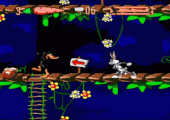
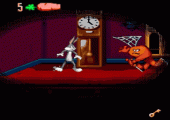
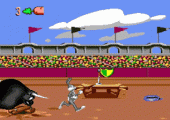
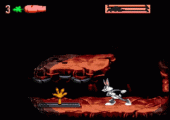
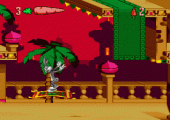
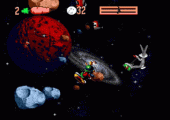
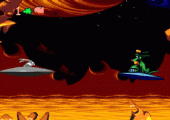
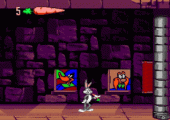
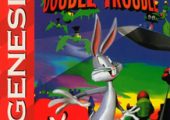
yeah i use a SEGA emulator to play all my games that i got in one big torrent file. something like almost 800 games. well, anyway Double Trouble was one of the games in the file and i thought i’d try it cause i grew up on Looney Tunes. i couldn’t get past the first stage before i gave up